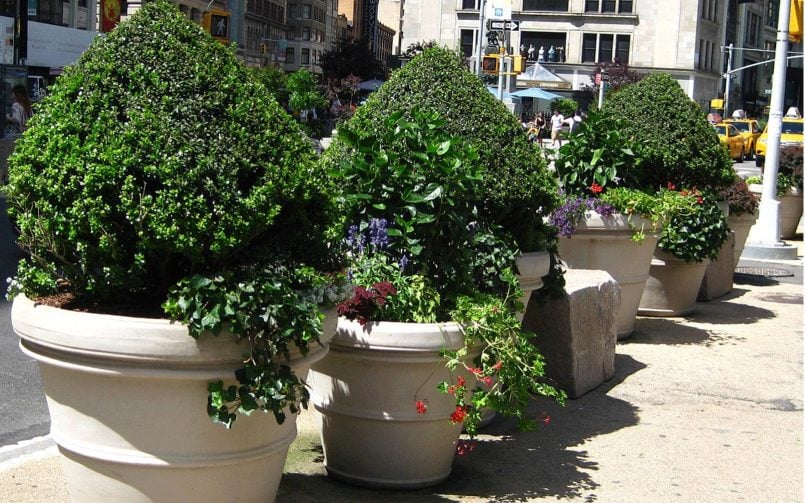You can grow beautiful trees in large planters to give your landscaping more height, or add some shade. But first, you need to be aware of the unique needs of trees grown in planters.
What Types of Trees Grow Well in Planters?
Certain trees can flourish in planters, but not all trees are up for the challenge. Your best bet is to go with smaller varieties, such as dwarf trees that experience slower and more manageable growth. If trees grow super-fast, you’ll constantly need to transport them into larger containers. Repotting a tree is a delicate and time consuming process.
You’ll also benefit from going with trees that have compact root systems. Trees with vast root systems are going to struggle growing in a confined space. To reduce maintenance, you may also want to avoid trees that drop a lot of seeds, foliage, or fruit during certain times of the year.
Beware, some of the best trees for containers do not thrive in all season-weather. If winters are harsh or particularly cold, the tree may need to be brought inside to prevent damages. On the other hand, if you live in a mild climate, you don’t have to worry about this too much. Do some research about the tree you plant beforehand, that way you know if it prefers shade, full sun, partial sun, and can handle cold weather, snow, etc.
Some good trees for planters to consider:
Conifers, namely evergreens, are great because they are low maintenance and don’t require as much food or nutrients as broad-leaf trees. Additionally, their root systems are better adapted to the confines of a planter.
Pines and Junipers make good options because they can thrive in drier soil, which is more common with planters.
Bamboo trees grow quickly in planters and make a great barrier for added privacy.
Small palm tree varieties look great in large planters, adding a tropical vibe to your property.
Standards are not trees, but rather shrubs that have been developed to look like trees. The lower branches are removed to form the appearance of a trunk. Some great examples include roses, boxwood, hibiscus, lilacs, and hydrangeas.
Your Climate Zone is Crucial
The best tree has everything to do with your location, climate, and what trees flourish in your part of the country. Trees in planters are more susceptible to climate conditions because their roots are not secured deep underground. That means the roots, aka the tree’s lifeline, have greater exposure to the weather and temperature swings. This fact causes many experts to advise using plants specified for one zone colder or warmer than the region you reside.
Keep in mind, potted trees can be moved to different locations, such as under a covered patio or into a garage, during harsh weather. If you are attracted to a type of plant that doesn’t thrive in cold or hot weather, just make sure you have a system in place to move it as needed.
Pick the Right Tree at the Nursery
When you go to pick out a tree, inspect the roots carefully to ensure you’re buying a tree that’s more prone to thriving as opposed to failing. You can buy trees that are bare-root, balled and bagged in burlap, or in containers. Buying trees in containers is the best way to ensure you are getting the whole root system.
Attempt to lift the tree out of the planter to make sure it isn’t root bound and will be easy to transplant. You should also make sure the roots appear healthy, and are a white or off-white color. Avoid roots that are circling, dark looking or slimy.
Pick the Right Planter for Trees
You’ll need a pot that is suited to the size of the tree, not just today, but a year from now after the tree experiences growth. The planter box should be at least twice the width and depth of the root ball. For every 4-feet of mature tree height, you’ll need an additional foot in container diameter.
Self-watering planters are a huge aid to potted trees. They prevent root rot by collecting additional water in a separate chamber. The roots can reach down and take water from this chamber as needed without having to soak in water for long periods of time. This reduces the risk of moldy roots almost entirely.
Last, but certainly not least, pick a planter that’ll withstand the test of time. Cheap plastic planters or heavy stone planters might look good at first, but they are highly susceptible to moisture, freeze/thaw damages, stains, and so forth.
How to Plant a Tree in a Planter
In most parts of the US, spring is the best season to plant trees. Before planting the tree, do your best to loosen the roots and use a sharp trowel to cut 1-2 inches off the root ball, cutting at a vertical slant. This will help spark fresh root growth.
Most trees prefer loose and well-drained soil, with some added compost. Slow-release organic fertilizer can be added to the soil for additional benefits. Add fertilizer in the spring and summer, but not in autumn. If you spark new plant growth in autumn, your tree could be in trouble when winter frosts arrive.
Before you plant the tree, take the time to measure the size of the root ball. Add an inch or two of pea gravel to the bottom of the container so that a solid layer of soil sits beneath the root ball. The root ball should be around 2 inches from the top rim of the container, just as it was in its nursery pot.
Shop our wide selection of planters: https://www.terracastproducts.com/our-shop/planters/

